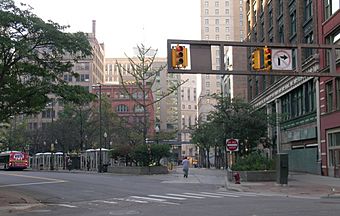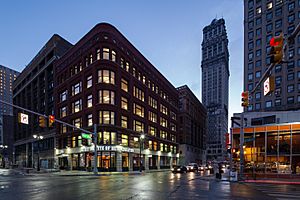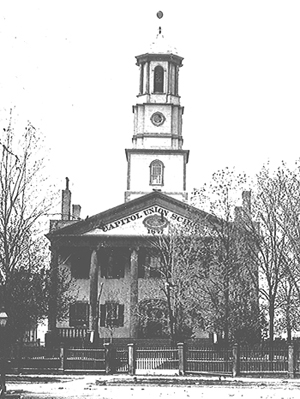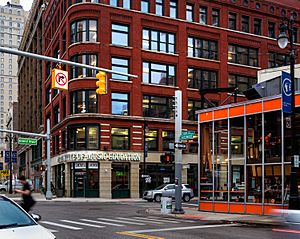Capitol Park Historic District facts for kids
Quick facts for kids |
|
|
Capitol Park Historic District
|
|

Capitol Park, from the north
|
|
| Location | Detroit, Michigan, U.S. |
|---|---|
| Built | 1877 |
| Architect | Albert Kahn Associates et al. |
| Architectural style | Italianate, Romanesque Revival |
| NRHP reference No. | 99000338 |
| Added to NRHP | March 18, 1999 |
The Capitol Park Historic District is a special historic area in downtown Detroit, Michigan. It's like a neighborhood filled with old and important buildings. This district is found near Grand River, Woodward, and Michigan Avenues, and Washington Boulevard. In 1999, it was added to the National Register of Historic Places. This means it's recognized as a place with a lot of history worth protecting.
Contents
What is Capitol Park?
Capitol Park is a triangular piece of land. Today, it's a public park where people can relax. This shape comes from the original city plan for Detroit made in 1805. The Historic District includes this park and seventeen buildings around it. These buildings stretch for about one block in every direction. Some famous buildings here are the Farwell Building, the Griswold Building, the David Stott Building, the Detroit Savings Bank Building, and the Industrial Building.
A Look Back: History of the Park
In 1823, Detroit was growing fast. The US Congress decided to give Michigan Territory its own government. So, a courthouse was built in Capitol Park between 1823 and 1828. When Michigan became a state in 1837, this building became the state's first capitol. It served as the capitol until 1847, when the government moved to Lansing.
After that, the building became a public high school. But in 1893, a fire destroyed it. The land was then turned into a park, and it has been a public space ever since.
The buildings around the park were mostly built in the early 1900s. They were used for businesses and shops. Famous architects like Albert Kahn designed some of them. You can see many different styles of buildings, from older Victorian designs to grand Beaux-Arts and modern Art Deco styles. These buildings show how Detroit changed from a busy 19th-century city to a modern one.
The Underground Railroad Connection
Capitol Park also has a special link to the Underground Railroad. This was a secret network that helped enslaved people find freedom. In 1850, a man named Seymour Finney bought land near the park. He built a tavern with a large barn. Finney strongly believed in ending slavery. He used his barn to hide people escaping slavery before they made their final journey across the river into Canada. Today, there's a historical marker in the park to remember Finney's Barn and its important role.
Michigan's First Governor
In 1905, the remains of Michigan's first governor, Stevens T. Mason, were brought to Capitol Park. He had died in New York City in 1843. A ceremony was held, and a statue of Mason was later placed over his grave.
In 2009, there were plans to change the park. This included moving the monument and grave. Crews searched for four days in 2010 to find his burial spot. It was thought the grave had been moved in 1955 to make space for a bus station. On October 27, 2010, Governor Mason was reburied for the fourth time. This happened on his 199th birthday, in a new vault under his bronze statue.
Capitol Park as a Transit Hub
The park has also been a major center for transportation in downtown Detroit. After the state capitol building burned down, streetcar lines were built around the new park. Large platforms were added, making it a busy transfer station.
In 1955, a bus terminal was built at the north end of the park. This led to Governor Mason's tomb being moved to the south end. The new bus station was made of steel and concrete. It had plastic skylights in its roof. The station was taken down in 1979, but the area around the park continued to be a main bus stop.
In 2001, the area was called the Capitol Park Transit Center. It was used as a temporary bus station until the Rosa Parks Transit Center was finished. When the Rosa Parks Transit Center opened in July 2009, Capitol Park stopped being a main transportation hub. A $1.1 million project started in September 2009 to update the park. This was done to help bring new businesses to the area.
Gallery
-
Farwell Building, looking through Capitol Park
-
Looking south on Griswold at State, with The David Stott Building on the left
Images for kids
See also
 In Spanish: Distrito Histórico de Capitol Park para niños
In Spanish: Distrito Histórico de Capitol Park para niños











